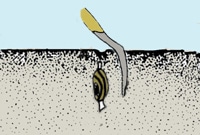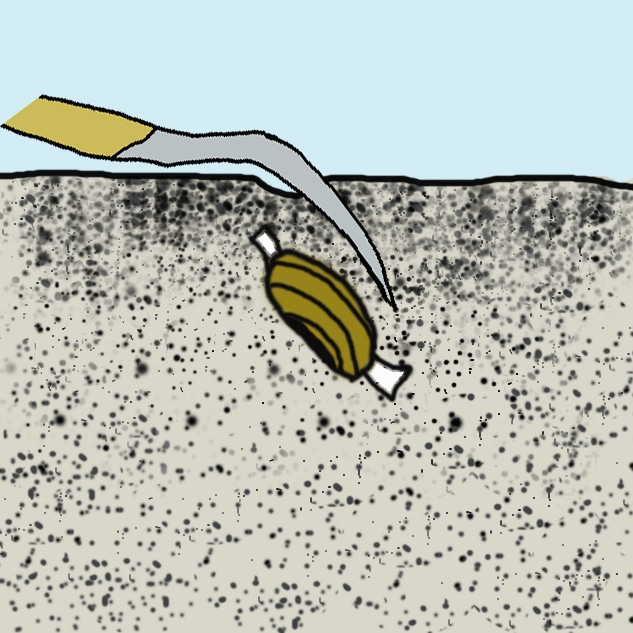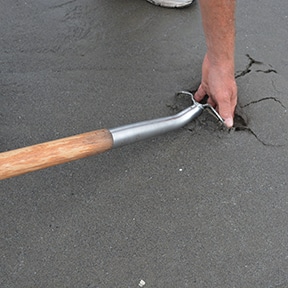Learn to Razor Clam… watch This Video!
Best For Beginners With a Shovel (click above for much more instruction)
Digging Razor Clams can be challenging, especially if you are using a clam shovel. Here are a few tips that will help you be successful digging your clams with a shovel without making what we call “clam chowder” (e.g., crushed, or cut up clams in your bag).

Clam Shows
When clams move or feed the disturbance in the sand creates a small hole or dimple in the sand. This is called a “Clam Show” Once you have found a clam, remember that razor clams can dig downward about a foot every thirty seconds, and they can be anywhere up to three feet deep. They can’t go sideways, but they can move downward fast in wet loose sand. You must also keep everything you dig, so no matter how small, crushed or broken, it counts toward your limit.
Shovel Can Cut Crush Your Clam

First time clammers can become frustrated using a shovel and having a limit of crushed, broken clams. Follow these steps and you’ll be sure not to crush or cut your clams in half!
Don’t Just Dig Into The Clam
The first thing to realize when your using a shovel is you don’t just start digging up the clam. It doesn’t matter what your approach is, as long as you don’t cut the clam in half. However; for beginners I strongly recommend digging around the clam 4″ to 6″, and not down into the clam. The best way is to turn your shovel around, and on the ocean side of the clam, about four to six inches from the “show” insert your shovel vertically and pull the sand out towards you.
Since your not digging down into the clam, you’ll be ensured an undamaged clam when you catch your prize. However, keep in mind that it is hard to determine how deep your clam is, so you might take two scoops out at first and then reach down with your hand and move toward the clam to see if you can find it.
Razors Dig Downward

Remember razor clams can dig downward about one foot every thirty seconds. In soft sand it can be faster and in heavy sand slower. Chances are if you’re new to clamming you are probably digging in hard sand, so your clam is digging but probably a foot every minute, and they stop at about three feet. If you can’t find the clam take a couple more scoops and give it another try, it could be up to three feet down. As long as your show was good the clam is there somewhere, so when digging clams be patient, and dig around the clam show until you find your prize.
Collect Your Prize

Eventually you’ll find the clam with your hand, that way you won’t crush the clam. It seems like everywhere I read about digging clams people say to be careful because razor clams are sharp and can cut you. I suppose that is why the name…razor clam, right. But, truth be known I’ve never been cut by a clam, none of my friends or kids either, and I would venture to say very few people have. Razor clams just aren’t that sharp, that doesn’t mean you shouldn’t be careful. After all when a razor clam shell is cut just right by your shovel, it can create a sharp edge, and when you reach in that would be more likely to cut you. So be cautious, but don’t get overly worried.
Open Razor Clamming Tides in Washington Frequently Change
Unlike Oregon the Washington Department of Fish and Wildlife schedules open Razor Clamming dates a few weeks or a few months in advance. But these dates are generally tentative and can change. Almost always, a few days prior to a dig, biotoxin level tests are done again. Consequently, a scheduled opening can change the day of a planned dig. Be advised, this is not that much of an inconvenience for locals but can make things exceedingly difficult for visitors.
Clam and Crab Biotoxin Testing
Always check shellfish safety with your States Department of Agriculture. Furthermore, your Department of Agriculture works in cooperation with the Oregon Department of Fish and Wildlife and Washington Department of Fish and Wildlife which have collected and tested shellfish for toxins. As a result, the area your clamming in may or may not be open and safe. Razsorclamming.com accepts no responsibility for the safety of crabs, clams, and similarly for the consumption of any shellfish.
Washington 24 Hour Shellfish Safety Hotline
Phone: 800-562-5632
Alt Phone: 360-236-3330
Oregon 24 Hour Shellfish Safety Hotline
Phone: 800-448-2474
Alt Phone: 503-986-4728